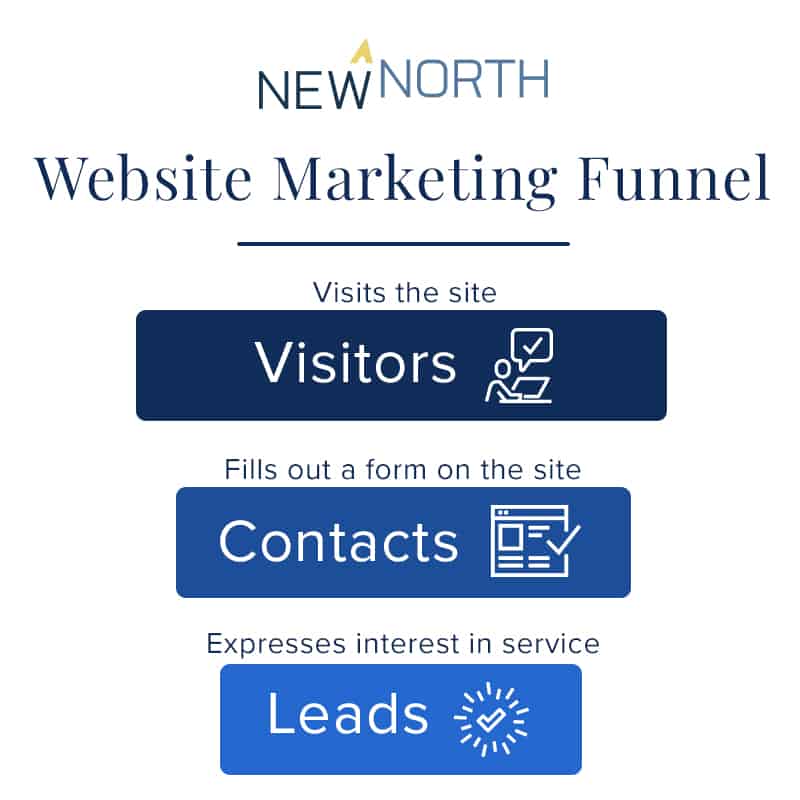Let’s start with a point that may be obvious but is probably worth clarifying anyway: MSP websites are incredibly valuable in any MSP lead generation campaign.
If you’ve landed on this article, you’re probably predisposed to nod your head in agreement at that. But the sentiment isn’t unanimous. The MSP companies we work with often face competition from firms that allocate very little (if any) attention toward websites. Most often, these firms are focused heavily on the sales side of the lead generation equation; they don’t have much of a website, but they do have people smiling and dialing to drum up new business, and the leads seem to come in okay. What gives?
Here’s the truth: your business can get by without a website that plays a role in lead generation. But your business will be far better off if your website is designed to generate leads.
Our clients (who clearly invest in digital marketing for their MSP firms) tend to climb past the firms that are forgoing a web focus over time. Sales people can drive MSP leads on their own, but when they’re supported by a solidly-crafted website that’s helping the cause, numbers increase.
So, with the value of an MSP website clarified, let’s dig in: how, exactly, can you build website to “help the cause”? Or, put another way: how can you create a website for your MSP firm that generates leads and supports your team?
Here’s how.
1. Set goals for your website.
The first step toward creating a MSP website for lead generation is to set smart (and, yeah, SMART – but that’s a topic for another post) goals.
The simplest way to do this is to quantify how many new MSP leads your website should bring in over a month. Basically, start at the bottom of the funnel.

Once you’ve arrived at this number, you’ll be able to work backward to determine other website goals based on your conversion rates. For example, if you want to generate 5 leads each month and 20% of your contacts become leads, you know that you’ll need your website to generate around 25 contacts each month. If you know that 2% of the visitors to your site become contacts, you’ll need to set a goal of achieving 1,250 site visitors each month. Each of these are quantifiable objectives that, if hit, will ensure your site’s getting the success you want.
Basically, if you want your website to help your sales team, you should set measurable goals that reflect that. Sometimes, MSP firms get caught up in the perception of prettiness and lose their grip on the reality of results. The goal of your website shouldn’t be to look pretty; it should be to generate leads. A pretty website might be a nice side-effect of a lead generation goal, but it’s not the main goal, and that’s an important distinction that can help you to avoid getting lost in the weeds of color scheme choices and logo size debates.
A Disclaimer: If you’re just getting started with using your MSP website for lead generation, you won’t have hard data around your conversion rates. That’s okay – for now. Use industry-standard rates in the beginning, then hone your models as they play out in real life. More on that later.
2. Design and develop toward those goals.
With your goals clarified, the next step is to design and develop your website toward achieving them. This is where things get tactical.
The truth is that web design is a topic worthy of at least its own post (and depending on who you talk to also a four-year-degree at a prestigious institution like Penn State), but for our purposes here we’ll outline some of the most consequential considerations.
Design each page with a focused purpose. Don’t bombard users with a vast array of potential actions. Make things easy for them by making it clear what you want them to do next. Focus on one core call-to-action per page. That might be a link to another page, an educational content offering, or the contact form – but whatever it is, don’t beat around the bush, and don’t design for distraction by trying to include everything at once. Make the intended flow of navigation clear and easy.
Design to content. Content is is crucial in driving visitors to convert. If you don’t believe that, try generating leads from a beautifully-designed site filled with lorem ipsum copy. We recommend starting with content and creating designs that amplify it (mainly because we’ve had a lot of success using this approach and seen much less success from sites that were built the other way around). Here’s more on the topic:
Develop to make search engines happy. As we saw during goal setting, generating visitors (traffic) is a foundational part of generating leads on a website. To get traffic, you’ve got to develop in a way that primes your site to show up on Google. That means building on platforms that optimize page speeds (we like WordPress, but there are plenty of good alternatives), incorporating schema, and making sure things are mobile-optimized.
3. Measure performance and optimize for leads.
Okay: you’ve set goals and built a site designed to meet them. Now it’s time to track your website’s performance and make it better.
This is where you’ll start to be able to determine your actual conversion rates. No longer will you have to rely on abstract industry metrics; you’ll be able to dig into real data and build on your results.
Funnel metrics (visitors, contacts, leads, and conversion rates) are really helpful here. Have you received 25 contacts without a single person actually expressing interest in your service? You may be misrepresenting the value of your firm, or targeting the wrong audiences entirely. Have you generated 2,000 site visits but gotten a measly 10 contacts? There’s a disconnect somewhere. Have you failed to generate much traffic at all? You’ll need to review your SEO efforts. Examining the stages of your funnel will help you to generate insights that improve your results.
Once you’ve identified areas to improve, start fixing them. Whatever that entails, it’s often beneficial to A/B test different options. Tools like HotJar (a behavior analysis tool) and Optimizely (an A/B testing tool) can improve the efficacy and validity of your tests.
4. Consistently create content.
Last but definitely not least, if you want to generate leads from your MSP website, you’ll need to consistently create content.
This is true for two reasons:
- Content pieces help to increase conversions.
- Strategic content helps boost rankings on Google.
In other words, creating content is hugely important for impacting every one of your website funnel metrics. Again, this a piece of website strategy worthy of its own four-year degree, but we’ll break things down into two main tactical focuses:
Create valuable content pieces to capture emails. A good way to do this is to answer potential clients’ biggest sales objections or most-asked service questions. Maybe this is something titled “One-Man IT Team vs. MSP Outsourcing,” or a more technical piece like “10 Ways to Protect Network Systems from Ransomware Attacks”. Content pieces should be purposed to provide prospects with helpful information and to establish your firm as a valuable solution.
Blog regularly (toward SEO-relevant keywords). Create a list of keyword-targeted blog topics and write them. You’ll have a better chance of showing up in search results if you publish content regularly – not to mention that you’ll be able to focus on longer-tail keywords than you’d be able to target on main site pages.
Want help? Get an MSP website designed and built by an expert marketing team.
Websites are valuable lead generation pieces; done well, a website can take your MSP company to the next level of growth, and this 4-step process is the backbone of good website development. If you follow it, results will come.
And if you want help, let’s talk.
At New North, digital marketing for B2B firms is what we do. We build MSP websites that work based on data, and we’ll help you ensure your site accomplishes your goals. Schedule a free 30-minute conversation today.



